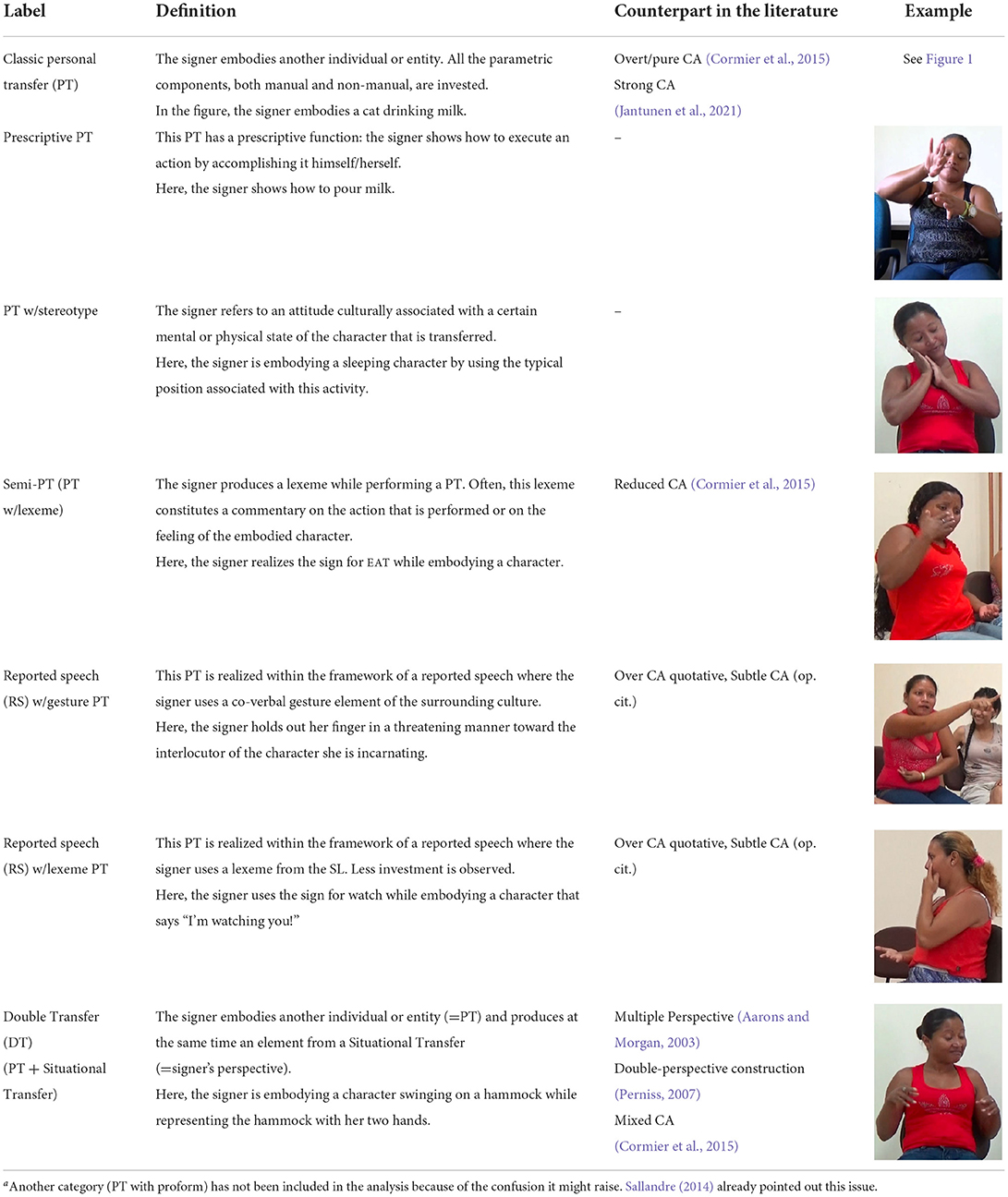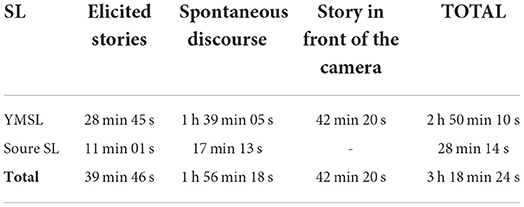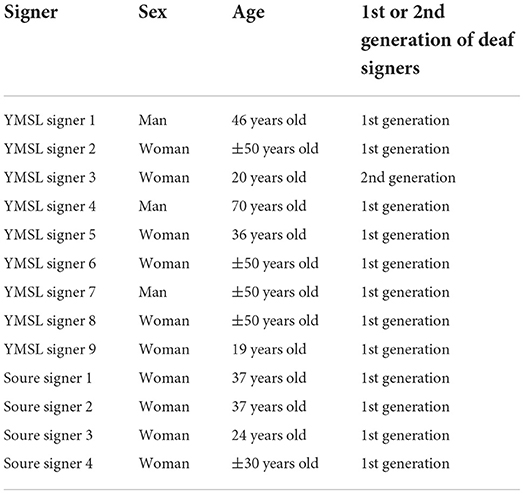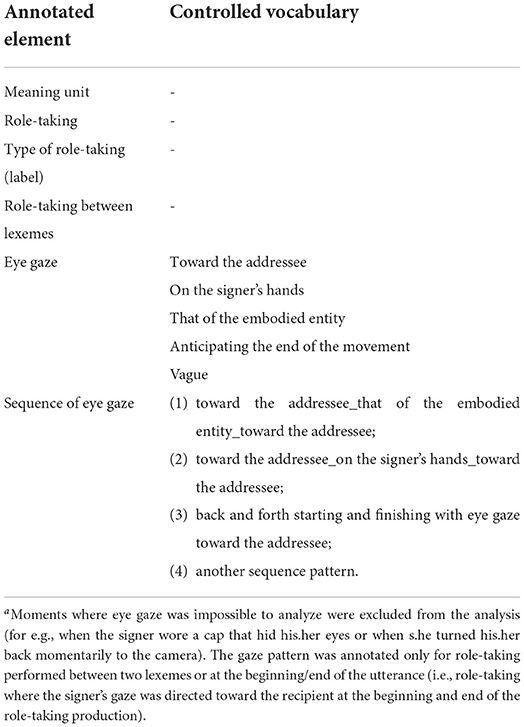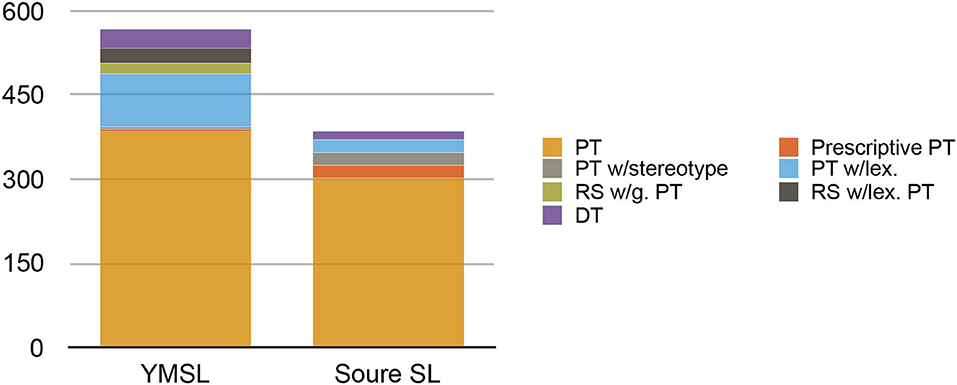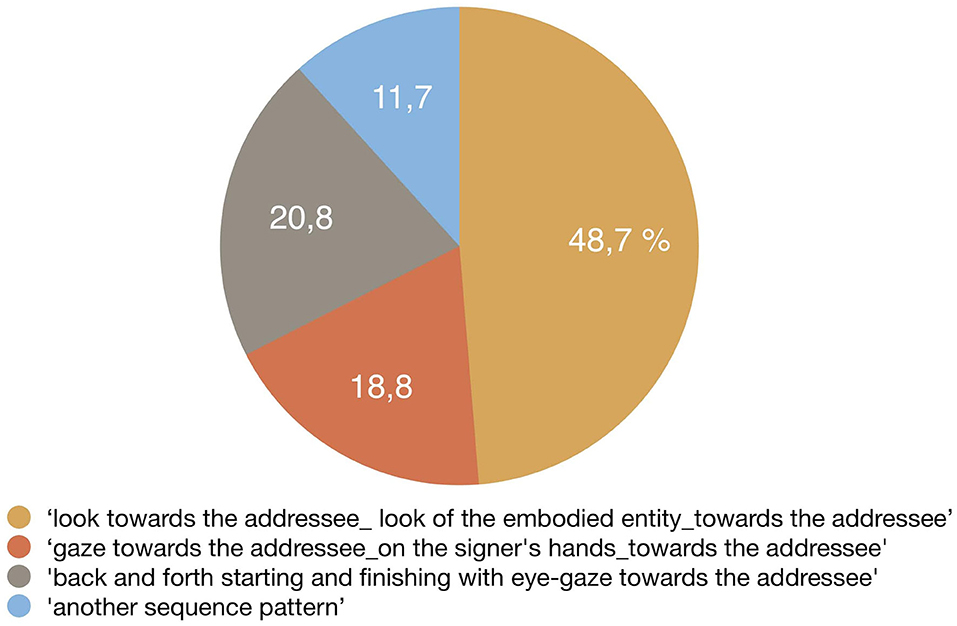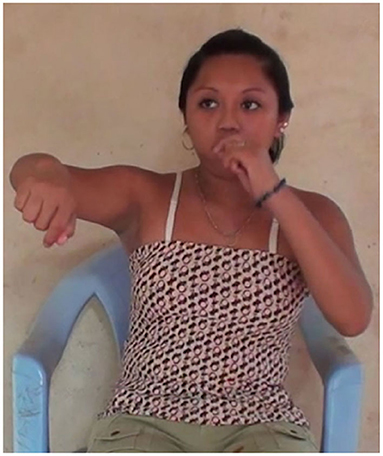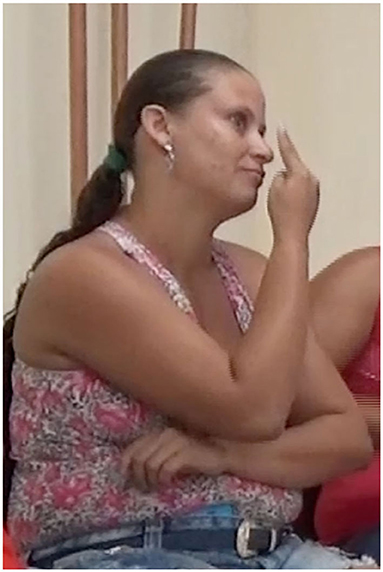- 1Consejo Nacional de Ciencia y Tecnología, Mexico City, Mexico
- 2Structures Formelles du Langage Laboratory, UMR 7023, Centre National de la Recherche Scientifique (CNRS), University of Paris 8 - University Paris Lumières, Paris, France
This study aimed to examine the use of role-taking constructions in two micro-community sign languages (SLs): Yucatec Maya SL (YMSL), and Soure SL. Various role-taking types were quantified and changes in gaze direction were annotated on data regarding these two SLs. The results showed (i) a greater diversity of role-taking produced in YMSL, including complex role-taking (i.e., multiple perspectives or role-taking produced alongside lexical units), and (ii) changes in gaze direction before and after the production of role-taking constructions in both SLs. First, this suggests a phylogenetic development between the two SLs partly observable from the study of role-taking through the conceptual lens of bifurcation of the signer's intent. More broadly, an analysis of the phylogenesis of SLs would benefit from this kind of examination using analytical concepts relevant to SLs. Second, results seem to indicate that the phylogenesis of SLs would share similarities with the ontogenesis of SLs. Indeed, the less socially integrated and analyzed SL (Soure SL) displayed a less advanced degree of bifurcation since few complex role-taking constructions were observed. This is in line with the way these structures are acquired late by SL learners. Further studies on other micro-community SLs would be needed to validate the results of this study.
Introduction
Role-taking corresponds to the possibility for a signer to embody a character or an entity in sign language (SL). As illustrated in Figure 1, during the realization of this linguistic structure, one or more articulators are involved (for example, the head, facial expression, eye gaze, shoulders, and torso).
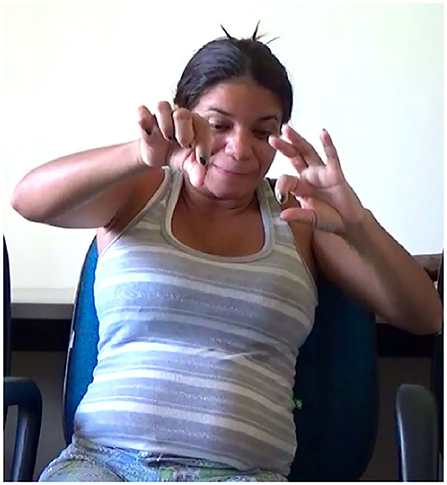
Figure 1. An example of role-taking (Martinod, 2019).
Today, several sets of categories coexist to refer to different role-taking in sign languages (SLs) depending on the authors' theoretical framework (see Supalla, 2003, and Lillo-Martin, 2012 for formalism; Cormier et al., 2015; Jantunen, 2017, and Liddell, 2003 for cognitive-functionalism; and Cuxac, 2000 and Sallandre, 2003, 2014 for the Semiological Approach). For instance, “constructed action” (CA)—the most widely used today—“constructed dialogue,” “role shift,” “point of view predicate,” “personal transfer,” “double transfer,” or “shifting reference”1.
Several studies showed that (i) role-taking constructions are narrative devices that are particularly rare in conversations (Ferrara and Johnston, 2014 for Auslan, and Jantunen, 2017 for Finnish SL), (ii) the production of complex role-taking constructions would require a high degree of language proficiency (Morgan, 2002; Slobin et al., 2003; Cormier et al., 2015; Sallandre et al., 2016b; Martinod, 2019), and (iii) a change in eye gaze is a marker for role-taking (a.o. Cuxac, 2000; Cormier et al., 2015; Sallandre et al., 2016b).
Ferrara and Johnston (2014) and Jantunen (2017) indeed report that the narrative register concentrates a high proportion of role-taking: 44% of the units for the frog story in Auslan (Ferrara and Johnston, 2014) and 65% for the same elicited story in Finnish SL (Jantunen, 2017).
Regarding the mastery of some role-taking constructions, Cormier et al. (2015, p. 26) suggest following the acquisition patterns, based on previous studies:
- Overt CA > Overt CA quotative > Reduced CA > Subtle CA2
- CA > Role Shift3
According to the authors, these trajectories could also stand for historical ones during an SL emergence (p. 33).
In addition, Mixed CA, also termed “multiple perspective constructions” (Aarons and Morgan, 2003), “double-perspective construction” (Perniss, 2007), or “double transfer” in the Semiological Approach (Cuxac, 2000 a.o), seems to be the latest acquired construction (Morgan, 2002; Slobin et al., 2003, p. 291–293).
Concerning the change in gaze direction, some authors consider it to be a marker of role-taking: Cuxac (2000), Fusellier-Souza (2006, 2012), Cuxac and Sallandre (2007), Sallandre and Garcia (2013), Cormier et al. (2015), Sallandre et al. (2016a,b), Garcia and Sallandre (2020), among others.
However, other recent studies suggest that eye gaze patterns vary and might not always be a key criterion in the production of role-taking: Ferrara and Johnston (2014); Jantunen et al. (2018, 2021); and Beukeleers and Vermeerbergen (2019a,b). For instance, Jantunen et al. (2018) observed eye gaze shift occurring with 81% frequency at the beginning of overt CA, but with only 58% frequency at the beginning of subtle CA. According to Beukeleers and Vermeerbergen (2019a,b), during enactments, signers frequently alternate their gaze between the enacted character and the recipient.
Like many phenomena in SLs, role-taking has been described for institutional SLs: presumably American SL according to Cormier et al. (2015) quoting Metzger (1995). Concerning micro-community SLs, although they are described increasingly for the past 30 years, role-taking in these SLs is often mentioned but rarely studied in depth nor in a comparative way. Therefore, there seems to be a gap in the literature on this subject while these languages are supposed to have different structures than the national SLs. Indeed, some authors refer to them by focusing on their diachronic evolution: they would become conventionalized over time (Zeshan, 2003).
Among other things, authors also specify their semantic utility as a representation of referents (Horton, 2020 a.o.). Concerning the gaze during the production of role-taking, Haviland (2020) speaks of “gaze to nowhere” in Z signing4. This is reminiscent of the “inexpressive gaze” described by Cuxac (2000, p. 55) for the role shift between two role-takings in French sign language (LSF). For YMSL, in particular, Le Guen et al. (2020a) pointed out that the perspective character used in role-taking is also widely used among Yucatec Maya hearing people of the region. Thus, role-taking might represent a privileged means of communication between deaf signers and hearing speakers. In line with this assumption, Safar (2019, p. 39 and 49) detailed two examples where role-taking was used to include two hearing men from the village of Chicán in a conversation between deaf female signers from another village, Cepeda Perraza. The author considered role-taking as part of translanguaging strategies between people (deaf and hearing) from different villages whose SL may differ.
Given the small number of studies devoted to role-taking in non-institutional SLs, this research provides an exploratory study on this topic. Our goal is to enrich typological knowledge about this linguistic phenomenon by examining possible structural differences between the types of role-taking used in two micro-community SLs. We focused on a comparative analysis of role-taking constructions in two sociolinguistically diverse SLs: Yucatec Maya SL (YMSL), used by several generations of signers including hearing signers in Yucatán, Mexico (a.o. Le Guen, 2012; Safar, 2019; Le Guen et al., 2020b), and Soure SL, which is a combination of former homesigns now in the process of social integration, used mostly by deaf signers on Marajó Island, Northeast Brazil. Soure SL is a very little studied SL, with the only existing studies to date being: Martinod (2013, 2019, 2022), Carliez and Fusellier (2016), Carliez et al. (2016), Garcia and Martinod (2017), and Martinod et al. (2020a,b). Using data collected in 2015 and 2017, an analysis was conducted to assess the proportion of role-taking constructions produced according to the type of speech and the diversity of role-taking used by each signer (Martinod, 2019). The current study focuses on YMSL data but Soure SL's data served as a basis for comparison.
After presenting our methodology in Section Methodology (Section Conceptual and analytical tools, Section Data, and Section Annotation), we present the results (Section Results). This section focuses on the impact of the type of discourse on the types of role-taking used (Section The impact of discourse type) and their frequency (Section Frequency of role-taking). We then examine the diversity of role-taking types between signers of the same SL (Section Diversity of role-taking: variation between signers of the same SL) and between SLs (Section Diversity of role taking: variation between SLs). Finally, we assess the role of the gaze (Section Eye-gaze and role-taking constructions) and conclude with our analysis based on the contributions of our study. These reflections concern the role of eye gaze (Section Eye gaze change as a marker of role-taking), the lack of terminological consensus (Section The lack of consensus on terminology: the case of Mixed CA/Double Transfer), which is a possible obstacle to future studies, the phylogenesis of SLs (Section Toward the hypothesis of a phylogenetic evolution between SLs and between signers of the same SL), and the links between phylogenesis and ontogenesis (Section Possible links between phylogenesis and ontogenesis).
Methodology
Conceptual and analytical tools
As mentioned above, the terminology used to refer to role-taking varies from one theoretical framework to another and sometimes even from one author to another. For this reason, in line with Cormier et al. (2015), it is essential to provide clear definitions, avoid confusion, and allow future comparisons on a common basis. The categories for designating role-taking are therefore defined below as well as a still-unknown analytical tool: the bifurcation of the signer's intent.
Categories referring to role-taking
Table 1 shows the seven categories used in the analysis to refer to role-taking and their closest counterparts in the terminology most used in the field. They have been developed by Sallandre (2003, 2014) based on Cuxac's research (2000)5. This choice is based on the accuracy these categories provide to describe semantically the possible range of role-taking in SL.
Some categories either do not appear to have an equivalent in the literature (e.g., Prescriptive PT) or correspond to several categories in the literature (e.g., Reported speech w/gesture).
Concept of bifurcation of the signer's intent
An analytical tool developed in the Semiological Approach is also used to bifurcate the signer's intent into two structural branches (Cuxac, 2000; Fusellier-Souza, 2006, 2012; Cuxac and Sallandre, 2007; Garcia and Sallandre, 2014, 2020). This process would occur during the emergence of SLs when the first productions' iconicity of a deaf individual isolated in a hearing environment is gradually structured into two ways of saying:
- an illustrative one, based on highly iconic structures (i.e., transfer structures, including role-taking presented in Table 1) recognizable from a formal characteristic: the breaking of eye gaze toward the addressee,
- a generic one, with no illustrative intent, based mostly on lexical units (LUs). An advanced degree of bifurcation, as observed in institutional SLs, would thus consist of a fine mastery of the production of LUs as well as complex and diverse transfer structures (such as role-taking) and specification of eye gaze (see Sallandre et al., 2016a for a study on seven institutional SLs).
Data
Spontaneous conversations and elicited data from both YMSL and Soure SL were analyzed as summarized in Table 2.
As presented in Table 3, data from 9 YMSL signers and 4 Soure SL signers were analyzed. For YMSL, only one signer out of 9 was a second generation signer. For Soure SL, all signers were first-generation deaf signers.
Annotation
Concerning YMSL data, annotations (segmentation of meaning units, preliminary identification of role-taking) were first made by two research assistants from Yucatán. While one research assistant was deaf, the other assistant was a child of a deaf adult (CODA) with a native command of YMSL. Then, annotations concerning the more precise delimitation of role-taking, labeling of role-taking, and change in the direction of eye gaze were made by the author (see Table 4 below, where the use or not of controlled vocabulary is specified). These were monitored and discussed regularly by Olivier Le Guen, a researcher on YMSL for about 10 years.
Data for Soure SL were referred from the author's thesis work (Martinod, 2019). Fully annotated by her, they were then checked and edited by two deaf signers from the North of Brazil and a Brazilian hearing SL user.
Results
The impact of discourse type
For both SLs, elicited discourse was the most likely to contain role-taking (19.55% for YMSL, and 21.60% for Soure SL). It is noteworthy that a similar proportion was observed even though the stimuli used for elicitation differed between SLs. YMSL signers had to transpose video stimuli made to elicit ditransitive constructions (e.g., a video showing a man giving a flower to a woman), whereas Soure signers were asked to transpose a story from various storyboards (e.g., a story about a man falling out of his hammock).
In YMSL, role-taking strongly prevailed in on-camera life narratives, occurring in about 22.75% of all instances, that is 491 units out of the 2,158 produced in this type of discourse. Since data from Soure SL do not include on-camera life narratives, we could not make a comparison on this point.
Frequency of role-taking
As shown in Figure 2, for both SLs, Classic PT was, by far, the most commonly produced. However, we can note differences between the two SLs regarding the other most commonly produced role-taking types. We found the following frequencies:
- In YMSL
Classic PT > PT with lexeme > DT > Reported speech PT w/lexeme
- In Soure SL
Classic PT > PT w/stereotype > PT with lexeme/Prescriptive PT > DT
First, it is worth noting that double transfer (DT), which was a construction previously described as a complex role-taking and probably acquired the latest, was among the three most commonly produced role-taking types in YMSL. In Soure SL, it was one and a half times less observed (3.66% of the produced role-taking for Soure SL vs. 5.78% in YMSL). Second, PT w/lexeme (a role-taking including the production of a lexeme while the signer embodies another character) represented 16.11% of all role-takings produced in the YMSL data while it represented only 5.48% of the role-taking in the Soure SL data. Third, PT w/stereotype was observed more in Soure SL than in YMSL (6.01% in Soure SL vs. 0.7% in YMSL).
Most frequently produced type of role-taking and type of discourse
Concerning the most commonly produced types of role-taking depending on the type of discourse, the following differences were observed.
For elicited data:
- In YMSL
Classic PT > DT > PT w/lexeme
- In Soure SL
Classic PT > Prescriptive PT > DT (PT w/lexeme being the fourth most frequently produced role-taking)
For spontaneous conversation data:
- In YMSL
Classic PT > PT w/lexeme > Reported speech PT w/lexeme
- In Soure SL
Classic PT > PT w/stereotype > PT w/lexeme (Prescriptive PT being then the most produced).
It would thus seem that the type of discourse influenced the proportion of role-taking produced. However, any specific pattern linked to a given type of discourse can be verified in the two SLs. Indeed, for both elicited data and data from spontaneous conversations, the hierarchy of most used role-taking types varied.
Least frequent role-taking
Among the role-taking that were rarely produced or not produced at all (i.e., <3%), we noticed the following:
- in YMSL
Prescriptive PT and PT w/stereotype
- in Soure SL
Reported speech PT w/lexeme and Reported speech PT w/gesture
For elicited data, in both YMSL and Soure SL, Reported speech PT w/gesture, Reported speech PT w/lexeme, and PT w/stereotype were the least produced. In addition, Prescriptive PT and PT w/stereotype were produced only in elicited data from YMSL.
Regarding spontaneous data in YMSL, PT w/stereotype, Prescriptive PT, and Reported speech PT w/gesture were the least produced. For Soure SL, it was Reported speech PT w/lexeme and DT.
Diversity of role-taking: Variation between signers of the same SL
In YMSL, for all but two signers, the most produced types were Classic PT and PT w/lexeme. One signer produced just four types of role-taking (the average in the data for this SL being about 63 role-taking per signer). The type of role-taking she produced the most was Reported speech PT w/lexeme. However, it turns out that Reported speech PT w/lexeme shares a feature with PT w/lexeme: it is another type of role-taking where the signer also produces a lexeme while being invested in an embodiment. It was therefore not so inconsistent that this role-taking was the most produced by this signer. The second signer followed the pattern produced by other signers, using the two most produced types of role-taking: Classic PT and Reported speech PT w/lexeme.
In Soure SL, on the other hand, only one signer followed the pattern observed in YMSL and produced a majority of Classic PTs and PTs w/lexeme. However, importantly, in Soure SL, the Classic PT is the role-taking produced by most signers. As mentioned in above, there were fewer PTs w/lexeme in Soure SL compared to YMSL. As for other signers, no particular pattern could be identified. Contrary to the exceptions we observed in YMSL, no Reported speech PT was at the second position of the most produced role-taking in Soure SL.
Differences among the diversity of role-taking types
There were significant differences between signers regarding the diversity of role-taking used. In YMSL, the signer with the highest role-taking diversity used seven different role-taking types while the one with the lowest diversity used only one type, and another one used three. In Soure SL, there was also a gap since the signer with the highest diversity used six different role-taking types. The one with the least diversity uses two while the others used five.
The YMSL signer who produced only three role-taking types was the only one from the second generation of deaf signers. This could have been an explanatory lead as all other participants were first-generation deaf signers, including the person who produced only one role-taking. The observed discrepancy between signers is perhaps due to the quantity of overall role-taking produced. Indeed, the signers in question in YMSL and Soure SL were also those who produced the least amount of role-taking compared to others. It is important to note that the Soure signer who produced the greatest diversity of role-taking (six types) was the one who was the most socially integrated: she interacted very regularly with both deaf and hearing people. For example, she often did occasional jobs at the homes of various hearing families from her neighborhood and also had a unifying role within the deaf community in Soure (see Martinod et al., 2020b). Conversely, the signer who used the least diversity (two role-taking types) was relatively more socially isolated. She often stayed with her hearing family and stepped out very little.
Despite these observations, it is still not easy to determine the potential expressive abilities of the signers in the absence of data to prove it. Perhaps these signers use other types of role-taking in other communication situations, but perhaps not.
Least frequent role-taking types
It should be mentioned that another role-taking category was temporarily added during the analysis of the YMSL data. This was “PT with the use of a real object”. It was eventually removed because it was hardly observed in the two SLs. In YMSL, for instance, only two signers produced it but in small quantities, and the other signers never produced it.
On other less frequently used role-taking types, among the YMSL signers, six out of nine never produced PT w/stereotype, four never produced Prescriptive PT, three never produce Reported speech PT w/lexeme, and two produced neither PT w/lexeme nor DT (see Figure 3).
In Soure SL, the only PT that was not produced by any of the four signers was Reported speech PT w/lexeme (see Figure 4).
Diversity of role-taking: Variation between SLs
It appears that there was a greater diversity of role-taking in YMSL as well as in the production of complex role-taking. To begin with, the median of the diversity of role-taking categories of both YMSL and Soure SL signers was five. However, the signer with the greatest diversity of role-taking types is a YMSL signer. He used seven different types while the signer with the highest type diversity in Soure SL used six.
Moreover, as mentioned above, PT w/lexeme is less produced in Soure SL than in YMSL (16.11% in YMSL and 5.48% in Soure SL). This role-taking has the particularity of integrating the lexicon within a role-taking.
Another element to consider is the production of DTs, a role-taking described in the literature as a complex construction that requires a significant body fragmentation and an excellent mastery of the different articulators used concomitantly. DTs represent 5.82% of role-taking produced in YMSL vs. 3.64% in Soure SL.
Eye gaze and role-taking constructions
The gaze examination focused only on the YMSL data, as the image quality of the Soure SL data did not allow a sufficiently fine examination of this feature.
Where do the signers look while producing a role-taking?
In total, 624 role-taking were examined. During the production of this type of construction, the signer's gaze corresponded to the gaze of the embodied entity for 57% of the time. This meant that the gaze was not directed toward the addressee during this amount of time. 20.1% of the time, the gaze was directed toward the addressee while 15.2% was toward the signer's hands. This gaze directed at the signer's hands generally corresponded to the gaze of the embodied entity performing an action. We chose to keep this distinction in the annotation because it seemed important to show that signers tend to look at their hands when the embodied character performed an action. The other 2.5% of the time, the gaze anticipated the end of the movement performed by the signer incarnating another character. Finally, 5.2% of the time corresponded to a vague gaze (cf. “gaze to nowhere”, Haviland, 2020).
If we examine each signer's gaze, the gaze being the embodied entity's during the production of a role-taking, it remained the most important proportion, except for one signer. It is the same signer who produced only one role-taking in all the data and it happens that his gaze is directed on his hands during the production. In other words, it is the gaze of the embodied entity that is placed on the hands of the signer.
Eye-gaze change of direction before/after role-taking production: A frequent pattern
Gaze direction provides information about the distribution of gaze during the production of role-taking, but it is not sufficient if we are to limit the analysis just to gaze direction in SL. Gaze direction chaining was therefore annotated following the annotation categories specified in Section Annotation. For this second sequence of gaze annotation, only role-taking that was preceded and followed by a lexeme or role-taking produced at the beginning or at the end of a unit utterance was taken into account (n = 154). The goal was to identify a pattern without being biased by the role-taking being itself followed or preceded by another role-taking or a Size and Shape Classifier (SASS). The results are presented below (Figure 5).
“Another sequence pattern” implies that the gaze is not detached from the addressee at the beginning and at the end of the role-taking. The sequences annotated “Another sequence pattern” were carefully examined individually. Some elements explain their presence at 11.7% (n = 18):
- In elicited data, in particular, the signer frequently looks at the physical stimulus before initiating a role-taking (n = 12). In these sequences, the gaze toward the interlocutor at the beginning of the role-taking is not observed but is observed at the end of it.
- Sometimes, the signer is not very involved in the role-taking and his gaze remains directed toward the interlocutor during the whole production (n = 4),
- The signer searches in his memories and his gaze is directed upward just before the role-taking (n = 1),
- The signer has a vague gaze just before the role-taking (n = 1).
This last pattern remains not only minor but it can be explained either by constraints of memorization of the task or by a lesser investment in role-taking. In general, data analysis suggests an almost systematic disengagement of the signer's gaze toward the addressee at the beginning of the role-taking. This gaze would be mostly redirected toward the interlocutor at the end of the role-taking. During the role-taking, the gaze is either the one of the embodied entity (48.7%), directed toward the hands of the signer who performs the actions of the embodied character (18.8%), or goes back and forth between the gaze of the embodied entity and the interlocutor (20.8%).
The back-and-forth pattern framed by a gaze toward the addressee at the beginning and at the end of role-taking has also been observed by Beukeleers and Vermeerbergen (2019a,b) for Flemish SL. In our data, the pattern's main concern was role-taking of long duration. Indeed, the median duration of the role-taking concerned by this pattern was 6 s 06 ms (mean duration: 7 s 58 ms). In comparison, the median duration of all the role-taking in YMSL data was 1 s 24 ms (average duration: 1 s 42 ms). Perhaps this duration would lead the signer to regularly ensure the attention of his interlocutor, using these quick glances directed toward him, while continuing the role-taking. However, not all long role-taking systematically displays this pattern in data.
To conclude, it seems that the data analysis strongly suggests that, on the one hand, YMSL signers look at their interlocutor before and after the production of the role-taking. On the other hand, during the production of this construction, a majority of the signers embodied another entity even in their gaze.
Discussion
The exploratory analysis presented in this study was conducted on data sets of 2 h 50 min 10 s for YMSL and 28 min 14 s for Soure SL. In other words, more data would be necessary to refine our results and sharpen the reflections presented in this study.
In both SLs, role-taking is less present in the spontaneous conversation data. We hypothesize that this lower production might be related to the content of the discourses but not necessarily to the nature of data. Indeed, life stories in YMSL are the type of discourse with the most role-taking, most of them being vivid narratives. For instance, in one of these narratives, the signer explains how a snake attacked a chicken in her garden. Such content is indeed very suitable for the expression of iconicity and, in especially, signers' bodily investment.
In spontaneous data sequence for YMSL, the signer who produces the most role-taking addresses topics such as his experience with illness, and then as a farmer and home builder. This type of topic seems to be suited to iconic representations.
Spontaneous data for Soure SL covered different issues. Martinod's (2019, p. 318–319) analysis showed that the proportions of role-taking were not the same and seemed to depend on the themes addressed by the signers. Role-taking was assumed more when the signers addressed topics such as their shared childhood memories or the effects of age on their health. On the other hand, there was very little role-taking when the signers talked about their place of residence in the city. This latter topic was more suited to the use of constructions using the signer's perspective where the city is represented in the signing space as a scene where the different homes are then placed.
This link between discourse type and preferential use of certain iconic constructions has already been highlighted by several authors (Sallandre, 2003; Ferrara and Johnston, 2014, among others). However, the question of the influence of the semantic content within a particular discourse genre on the production of role-taking remains to be explored. To better understand this influence, we would need to analyze data where the signers would have a “spontaneous” conversation6 with themes more suitable to iconic representation.
Eye gaze change as a marker of role-taking
Out of the 624 role-taking in our corpus, 154 corresponded to our analysis criteria concerning the change of gaze direction. As a reminder, these criteria were as follows: to be preceded and followed by a lexeme or to be located at the beginning or at the end of a speech utterance. Based on the percentages presented in Section Eye-gaze change of direction before/after role-taking production: a frequent pattern, out of these 154 role-takings, 88.3% show a change in the direction of the signer's gaze. This result suggests, following Cuxac (2000), Sallandre (2003, 2014), and Cormier et al. (2015), that gaze is a marker of role-taking in YMSL.
The next step would be to extend this analysis with an identical methodology for Soure SL and for other non-institutional SLs. A hypothesis to be tested would be that gaze direction command could also be an indicator to assess bifurcation advancement in an SL.
The lack of consensus on terminology: The case of mixed CA/double transfer
Mixed CA is defined as “a role-taking of two characters simultaneously” (Cormier et al., 2015). In the Semiological Approach, DT is seen as a type of role-taking involving the signer's body and the concomitant realization of a localization element from another construction involving a signer's perspective. This means that, according to this approach, Figures 6–8 below are all considered DTs even if they are structurally and semantically different.
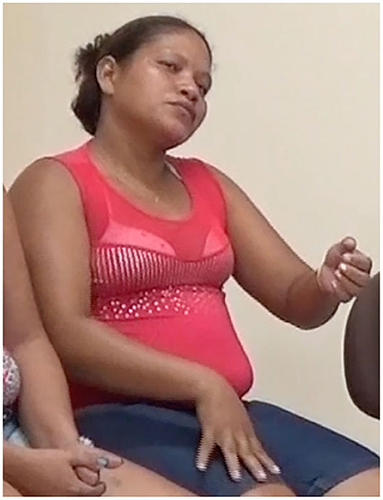
Figure 6. An example of a DT in Soure SL, from Martinod (2019).
For instance, Figure 6 shows a Soure SL signer embodying herself in the past while simultaneously representing the pain she felt at that time when spreading long her leg (i.e., Classic PT + the representation of another entity). Figure 7 shows a YMSL user embodying a dead snake while her right arm stands for her actual arm (in the past) holding the animal and her left hand represents the snake's tongue hanging (Classic PT + a part of another Classic PT + a proform7). Figure 8 shows another Soure SL user embodying herself while being watched by people from the village (Classic PT + modified lexeme TO LOOK AT/the representation of the part of another entity). Finally, Figure 9 shows an LSF signer embodying a cat while her left hand represents a bowl and her right hand the cat's tongue (Classic PT + the realization of a localization element from another construction involving a signer's perspective + a proform).
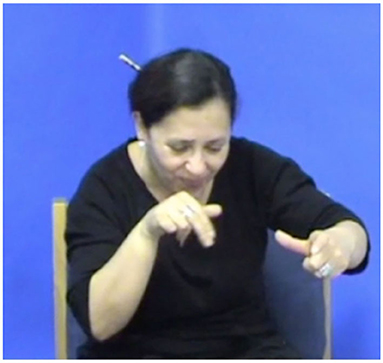
Figure 9. An example of a DT in LSF, from Creagest corpora (Sallandre and L'Huillier, 2011).
Thus, Figures 7 and 9 represent DTs with a higher semantic 1153 density since each articulator (the signer's body and her two hands and/or arms) has a different meaning. Nonetheless, all also constitute complex constructions involving the representations of (at least) two entities or part of entities.
When annotating our data, both definitions were included under the label ‘DT'. However, this broader conception of what constitutes a DT does not seem to be widespread in the literature through the use of the label “Mixed CAs”.
This problem, which has already been pointed out in previous studies, seems to remain an issue. It does not facilitate the comparison between SLs. Of course, the use of another terminology from the Semiological theoretical approach does not simplify the situation. However, this shows the diversity that can exist and the relevance of some categories for the analysis of these constructions that are not yet sufficiently described in the SLs and whose significance for SL phylogenesis is still to be explored.
Toward the hypothesis of a phylogenetic evolution between SLs and between signers of the same SL
First, for both SLs, the most produced role-taking is the Classic PT. It would therefore be the least complex construction to produce, previously described as an iconic “macro-structure” (Cuxac, 1985, 1996, 2000, 2013). Then, in YMSL, the two least produced types of role-taking are PT w/stereotype and Prescriptive PT. It should be noted that PT w/stereotype and Prescriptive PT are role-taking whose semantic function is very precise: the reference to a culturally marked attitude to represent a physical or mental state of the embodied entity for PT w/stereotype; the prescription for Prescriptive PT. If the semantic content of data does not lend itself to this, it seems less likely that such role-taking will be observed. In Soure SL, PTs w/stereotype related to a particular motherhood stereotype, such as typical attitudes toward taking care of a baby. In addition, a good number of Prescriptive PTs were observed during the spontaneous conversation sequence where several signers mentioned, for example, their depilation techniques. Here again, it would seem that this result in YMSL was mostly related to semantic content. This could also explain why, in both SLs, Reported speech PT w/gesture and Reported speech PT w/lexeme were globally less produced.
As mentioned above, in Soure SL, it is the Semi-TP that is the least produced construction. Semi-TP is a role-taking that includes the production of a lexeme while the signer embodies an entity/a character. This low quantity of Semi-TP in Soure SL could be explained by the fact that the lexicon of this SL presents more lexical variation. Indeed, the social integration of this SL is still in progress. This is also observed in dialogic situationshere signers tend to use few lexemes and rely more on iconic constructions to convey meaning (Martinod, 2019, p. 285). This observation thus seems to be mostly related to the stabilization of the lexicon. Regarding the diversity of role-taking used in YMSL, one signer used all seven role-taking types listed while another used only one. In Soure SL, the signer who used the most used only six and another used two.
Taken together, these results indicated the existence of a small gap in bifurcation advancement both between the two SLs and between signers of the same SL. So far, it is difficult to find an explanation for the difference in bifurcation advancement between YMSL signers. Similarly, for the Soure SL signers too, this difference exists. However, for Soure SL signers, we highlighted the fact that this gap is certainly due to sociolinguistic factors.
In addition, YMSL signers appear to use a greater proportion of DT. This confirms the study of Le Guen et al. (2020a) who pointed out the likely influence of surrounding cultural gestures on the production of this type of complex construction in YMSL. However, the hypothesis of a more advanced bifurcation in YMSL, manifested by the production of more diverse and complex role-taking, could also explain this finding. However, these results should be taken with caution as they may also be related to the amount of data analyzed. These results are less important for Soure SL as only what was produced in front of the camera could be relied upon, and there is still some doubt about the potential abilities of the signers off camera. The ease with which they express themselves naturally is an element to be taken into account, as well as the diversity of the themes expressed.
To conclude, these observations suggest the existence of a slight gap in bifurcation between the two studied SLs. This discrepancy seems to be mainly due to the issue of lexical stabilization, which would be less advanced for Soure SL. Of course, this does not constitute a value judgment, as lexical stabilization is not a goal to be achieved for an SL. We recall in this regard the importance of not considering institutional SLs as a telos for other SLs (see Nyst, 2012, p. 566). Even if an SL has a lot of lexical variation, this does not necessarily constitute an obstacle for communication between signers.
Concerning the hypothesis of a phylogenetic evolution between SLs, the constraint of the limited amount of analyzed data calls for caution. Ideally, it would be helpful to compare our data with (i) a non-institutional SL whose degree of social integration would be more advanced than YMSL, and (ii) a homesign, whose social integration would be, as a matter of fact, less advanced than YMSL and Soure SL.
Possible links between phylogenesis and ontogenesis
We focused on the production of three constructions described in the literature as acquired late by a SL learner. First, DTs are described in the literature as complex constructions to produce. They would therefore be acquired the latest by a SL learner. Given that DTs are less produced in Soure SL, a SL that would be at a less advanced stage of bifurcation than YMSL, it seems consistent to draw a parallel between phylogenesis and ontogenesis.
A second construction also described as probably acquired the latest is role shift (i.e., when the signer performs several role-taking constructions in a row where the embodied character/entity changes rapidly, Cormier et al., 2015). This feature was not annotated in our data due to its low presence. Nevertheless, future studies should address this aspect in non-institutional SLs. This might confirm the phylogenetic pattern through which an SL would pass.
Finally, a third example is Subtle CA. This construction is described as acquired late, like role shift. In Table 1, which shows the supposed correspondences between our labels and those found in the literature, Subtle CA is associated with Reported speech w/gesture and Reported speech w/lexeme. It turns out that, for both SLs, these types of role-taking are very rarely produced. These two elements tend to confirm the acquisition pattern proposed by Cormier et al. (2015) but still concern the phylogeny of two SLs.
Data availability statement
Publicly available datasets were analyzed in this study. A part of this data can be found here: https://www.ortolang.fr/market/corpora/corpus-these/v1.
Ethics statement
The studies involving human participants were reviewed and approved by Center for Research and Higher Studies in Social Anthropology (Centro de Investigaciones y Estudios Superiores en Antropologia Social) (CIESAS). The patients/participants provided their written informed consent to participate in this study. Written informed consent was obtained from the individual(s) for the publication of any potentially identifiable images or data included in this article.
Author contributions
EM designed the manuscript and wrote all the sections.
Funding
This work was possible thanks to a funding from the Fondi Institucional del CONACYT (FOINS), Funding No. FC 2016-2893, Documentación de una Nueva Lengua Indígena En México: La Lengua de Señas Maya Yucateca Project. Principal investigator: Dr. Olivier Moise Patrick Le Guen (CIESAS). The publication of this work was made possible thanks to the CNRS, by the Structures formelles du Langage Laboratory.
Acknowledgments
We thank the deaf signers involved in this study from Yucatán (Mexico) and Soure (Marajó Island, Brazil). We acknowledge the authors of the corpora for permission to use the source material in this paper: Olivier Le Guen and Josefina Safar. The author thanks Dr Le Guen for revision of the manuscript with formal and substantive comments.
Conflict of interest
The author declares that the research was conducted in the absence of any commercial or financial relationships that could be construed as a potential conflict of interest.
Publisher's note
All claims expressed in this article are solely those of the authors and do not necessarily represent those of their affiliated organizations, or those of the publisher, the editors and the reviewers. Any product that may be evaluated in this article, or claim that may be made by its manufacturer, is not guaranteed or endorsed by the publisher.
Footnotes
1. ^See in particular, Cormier et al. (2015) for a critical review of these terms.
2. ^The features of abovementioned CAs are as follows: Overt CA: clear role-taking without lexeme; Over CA quotative: clear role-taking with reported speech; Reduced CA: the role-taking is reduced and some narration is involved through comments; Subtle CA: differs from Reduced CA by the number and/or intensity of involved articulators (e.g., only eye gaze is enacting the eye gaze of the character).
3. ^For the authors, “unlike CA which is a stretch of discourse (however short or long) that represents one role or a simultaneous combination of roles, Role Shift is characterized as a shift between roles”.
4. ^Z signing refers to “Zinacantec family homesign”, a SL emerging over the past three decades in a family from a remote Mayan Indian village (Haviland, 2015).
5. ^The reader can also refer to Sallandre (2003, p. 139–159) and Martinod et al. (2020a, p. 207) for more illustrated examples.
6. ^With all the ambiguity that this expression carries given that signers know that they are being filmed during the exchange.
7. ^Or entity classifier.
References
Aarons, D., and Morgan, R. (2003). Classifier predicates and the creation of multiple perspectives in South African sign language. Sign Lang. Stud. 3, 125–156. doi: 10.1353/sls.2003.0001
Beukeleers, I., and Vermeerbergen, M. (2019a). “On the role of eye gaze in depicting and enacting in Flemish Sign Language : some methodological considerations,” in A Paper Presented at the International Research Network EURASIGN, April 5th, University Paris 8, Paris.
Beukeleers, I., and Vermeerbergen, M. (2019b). “On the role of eye gaze in depicting in Flemish Sign Language narratives,” in Conference International Cognitive Linguistics Conference (ICLC15), August 6th, Nishinomiya.
Carliez, M. L. S. S., Formigosa, E., and Cruz, E. B. (2016). Accessibilité et égalité des chances aux micro-communautés des sourds brésiliens: Vers la reconnaissance des langues des signes pratiquées par les sourds de Soure (Île de Marajó) et Fortalezinha-PA et Porto de Galinhas-PE. MOARA Revista Eletrônica Programa Pós-Graduação em Letras. 1, 128–143. doi: 10.18542/moara.v1i45.3711
Carliez, M. L. S. S., and Fusellier, I. (2016). Collecte des langues des signes des sourds de Soure (Île de Marajó): Un parcours méthodologique (2008/2013), les enjeux sociaux et politiques de la non reconnaissance des langues des signes émergentes pratiquées par ces sourds. MOARA Rev. Eletrônica Program. Pós-Graduação em Letras. 1, 144–160. doi: 10.18542/moara.v1i45.3712
Cormier, K., Smith, S., and Sevcikova Sehyr, Z. (2015). Rethinking constructed action. Sign Lang. Linguistics 18, 167–204. doi: 10.1075/sll.18.2.01cor
Cuxac, C. (1985). “Esquisse d'une typologie des langues des signes,” in Autour de la langue des signes, Journées d'Études 10. UFR de linguistique générale et appliquée, eds Cuxac, C.(Paris: University René Descartes), 35–60.
Cuxac, C. (1996). Fonctions et structures de l'iconicité des langues des signes. Analyse descriptive d'un idiolecte parisien de la langue des signes française. (PhD thesis). University Paris 5, Paris, France.
Cuxac, C. (2013). Langues des signes: Une modélisation sémiologique. La nouvelle revue de l'adaptation et de la scolarisation 4, 65–80. doi: 10.3917/nras.064.0065
Cuxac, C., and Sallandre, M. (2007). “Iconicity and arbitrariness in French Sign Language : Highly Iconic Structures, degenerated iconicity and diagrammatic iconicity,” in Verbal and Signed Languages : Comparing Structures, Constructs and Methodologies, Vol. 36. eds E. Pizzuto, P. Pietrandrea, R. Simone (Berlin: Mouton de Gruyter), 13–33.
Ferrara, L., and Johnston, T. (2014). Elaborating who's what: a study of constructed action and clause structure in Auslan (Australian Sign Language). Austr. J. Ling. 34, 193–215. doi: 10.1080/07268602.2014.887405
Fusellier-Souza, I. (2006). Emergence and development of signed languages: from a semiogenetic point of view. Sign Lang. Stud. 7, 30–56. doi: 10.1353/sls.2006.0030
Fusellier-Souza, I. (2012). “Multiple perspectives on the emergence and development of human language : B. Comrie, C. Perdue and D. Slobin,” in Comparative Perspectives on language Acquisition : A Tribute to Clive Perdue., eds M. Watorek, S. Benazzo and M. Hickmann. (Bristol: Second language acquisition: 61, Multilingual Matters), 223–244.
Garcia, B., and Martinod, E. (2017). Ancrage perceptif et invariant dans les langues des signes (LS), langues de sourds. Echo des Etudes Romanes Ceske Budejovice. XIII, 73–88. doi: 10.32725/eer.2017.006
Garcia, B., and Sallandre, M.-A. (2014). “Reference resolution in french sign language,” in Crosslinguistic Studies on Noun Phrase Structure and Reference, eds P. C. Hofherr and A. Zribi-Hertz Vol. 39 (Brill), 316–364. Available online at: https://hal.archives-ouvertes.fr/hal-01038427/.
Garcia, B., and Sallandre, M.-A. (2020). Contribution of the semiological approach to deixis–anaphora in sign language: the key role of eye-gaze. Front. Psychol. 11, 2644. doi: 10.3389/fpsyg.2020.583763
Haviland, J. (2020). “Signs, interaction, coordination, and gaze : Interactive foundations of “Z”—An emerging (sign) language from Chiapas, Mexico,” in Emerging Sign Languages of the Americas, eds O. Le Guen, J. Safar, M. Coppola (Berlin: De Gruyter), 35–96.
Horton, L. (2020). “Representational strategies in shared homesign systems from Nebaj, Guatemala,” in Emerging Sign Languages of the Americas, eds O. Le Guen, J. Safar, M. Coppola (Berlin: De Gruyter), 97–154.
Jantunen, T. (2017). Constructed action, the clause and the nature of syntax in Finnish Sign Language. Open Linguistics. 3, 65–85. doi: 10.1515/opli-2017-0004
Jantunen, T., Burger, B., and Puupponen, A. (2018). “Constructed action types and eye behavior in Finnish Sign Language,” in A Paper Presented at the 8th Conference of the International Society for Gesture Studies (ISGS 8) Organized in Cape Town.
Jantunen, T., De Weerdt, D., Burger, B., and Puupponen, A. (2021). The more you move, the more action you construct A motion capture study on head and upper-torso movements in constructed action in Finnish Sign Language narratives. Gesture 19, 76–101. doi: 10.1075/gest.19042.jan
Le Guen, O. (2012). “An exploration in the domain of time: From Yucatec Maya time gestures to Yucatec Maya Sign Language time signs,” in Endangered Sign Languages in Village Communities: Anthropological and Linguistic Insights, eds Zeshan U and De Vos C. (Berlin: Mouton de Gruyter and Ishara Press), 209–250.
Le Guen, O., Petatillo, R., and Kinil Canché, R. (2020a). “Yucatec Maya multimodal interaction as the basis for Yucatec Maya Sign Language,” in Emerging Sign Languages of the Americas, eds O. Le Guen, J. Safar, M. Coppola (Berlin: De Gruyter).
Le Guen, O., Safar, J., and Coppola, M. (2020b). Emerging Sign Languages of the Americas. Boston and Lancaster: Walter de Gruyter GmbH and Co KG. doi: 10.1515/9781501504884
Liddell, S. K. (2003). Grammar, Gesture, and Meaning in American Sign Language. Cambridge: Cambridge University Press.
Lillo-Martin, D. (2012). “Utterance reports and constructed action in sign and spoken languages,” in Sign Language – An International Handbook (Handbooks of Linguistics and Communication Science), eds R. Pfau, M. Steinbach, B. Woll (Amsterdam: Mouton de Gruyter), 365–387.
Martinod, E. (2013). Les LS pratiquées par des sourds isolés de l'île de Marajó (master's thesis). Supervisor: Brigitte Garcia. University Paris VIII - ENS Ulm.
Martinod, E. (2019). Approche typologique des composants minimaux porteurs de sens dans plusieurs langues des signes (LS) se situant à divers degrés de communautarisation. Implications pour une typologie des LS et apports d'un premier examen phylogénétique des LS du Marajó (PhD thesis). University Paris 8, Paris, France.
Martinod, E. (2022). Apports d'une approche pluridisciplinaire pour la description de langues des signes micro-communautaires, Conference Les Rencontres Jeunes Chercheurs 2020. Paris: University Sorbonne Nouvelle - Paris 3.
Martinod, E., Garcia, B., and Fusellier-Souza, I. (2020a). “An emerging sign language and sign language typology : the case of the Marajó Island (Brazil),” in Emerging Sign Languages of the Americas, eds O. Le Guen, J. Safar, M. Coppola (Berlin: Mouton de Gruyter), 203–250.
Martinod, E., Garcia, B., and Fusellier-Souza, I. (2020b). “Sign languages on Marajó Island (Brazil)—sociolinguistic sketch,” in Emerging Sign Languages of the Americas, eds O. Le Guen, J. Safar, M. Coppola (Berlin: Mouton de Gruyter), 425–430.
Metzger, M. (1995). “Constructed dialogue and constructed action in American Sign Language,” in Sociolinguistics in Deaf Communities, eds C. Lucas (Washington, DC: Gallaudet University Press), 255–71.
Morgan, G. (2002). Children's Encoding of Simultaneity in British Sign Language Narratives. Sign Lang. Ling. 5, 131–165. doi: 10.1075/sll.5.2.04mor
Nyst, V. (2012). Shared Sign Languages. Sign Languages. An International Handbook. Berlin: Mouton de Gruyter, 552–574.
Perniss, P. M. (2007). Achieving spatial coherence in German Sign Language narratives: the use of classifiers and perspective. Lingua 117, 1315-1338. doi: 10.1016/j.lingua.2005.06.013
Safar, J. (2019). Translanguaging in Yucatec Maya signing communities. Appl. Ling. Rev. 10, 31–53. doi: 10.1515/applirev-2017-0082
Sallandre, M.-A. (2003). Les unités du discours en Langue des Signes Française. Tentative de catégorisation dans le cadre d'une grammaire de l'iconicité (PhD thesis). University Paris 8, Paris, France.
Sallandre, M.-A. (2014). Compositionnalité des unités sémantiques en langues des signes. Perspective typologique et développementale (Thèse HDR). University Paris 8, Paris, France.
Sallandre, M.-A., Di Renzo, A., and Gavrilescu, R. (2016a). “Various types of personal transfers (constructed actions) in seven sign languages,” in Poster Presented at Theoretical Issues in Sign Language Research Conference (TISLR 12). Melbourne, VIC: La Trobe University
Sallandre, M.-A., Di Renzo, A., Gavrilescu, R., and Daniel, A. (2016b). “Embodiment and discourse cohesion in five sign languages,” in Paper Presented at the 7th Conference of the International Society for Gesture Studies (ISGS), Paris, July 21st.
Sallandre, M.-A., and Garcia, B. (2013). “Epistemological issues in the semiological model for the annotation of sign language,” Sign Language Research, Uses and Practices, Crossing Views on Theoretical and Applied Sign Language Linguistics, eds M. de Gruyer (Boston and Nijmegen: Ishara Press), 159–177.
Sallandre, M.-A., and L'Huillier, M.-T. (2011). Corpus Creagest-Acquisition, LSF enfantine. Paris: ANR Corpus.
Slobin, D. I., Hoiting, N., Kuntze, M., Lindert, R., Weinberg, A., Pyers, J., et al. (2003). “A cognitive/functional perspective on the acquisition of “classifiers”,”xs in Perspectives on Classifier Constructions in Sign Languages, eds K. D. Emmorey (Mahwah, NJ: Lawrence Erlbaum Associates), 271–296.
Supalla, T. (2003). “Revisiting visual analogy in ASL classifier predicates,” in Perspectives on Classifier Constructions in Sign Languages. ed K. Emmorey (Mahwah: Psychology Press), 259–268.
Keywords: Yucatec Maya SL, Soure SL, non-institutional SL, enactment, embodiment, constructed action, eye gaze, Semiological Approach
Citation: Martinod E (2022) Role-taking in two micro-community sign languages: Phylogenetic insights. Front. Commun. 7:780063. doi: 10.3389/fcomm.2022.780063
Received: 20 September 2021; Accepted: 21 June 2022;
Published: 02 August 2022.
Edited by:
Sabina Fontana, University of Catania, ItalyReviewed by:
Mari Carmen Campoy-Cubillo, University of Jaume I, SpainKostas Karpouzis, Panteion University, Greece
Copyright © 2022 Martinod. This is an open-access article distributed under the terms of the Creative Commons Attribution License (CC BY). The use, distribution or reproduction in other forums is permitted, provided the original author(s) and the copyright owner(s) are credited and that the original publication in this journal is cited, in accordance with accepted academic practice. No use, distribution or reproduction is permitted which does not comply with these terms.
*Correspondence: Emmanuella Martinod, ZW1tYW51ZWxsYS5tYXJ0aW5vZEBnbWFpbC5jb20=
 Emmanuella Martinod
Emmanuella Martinod